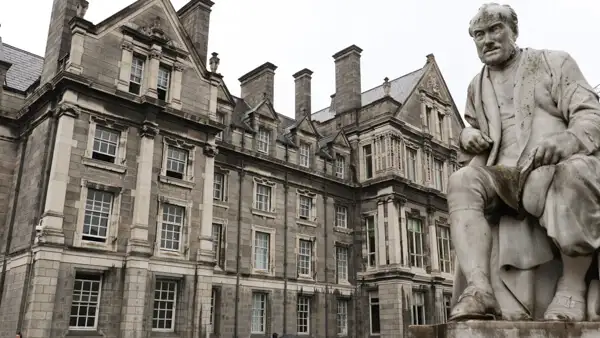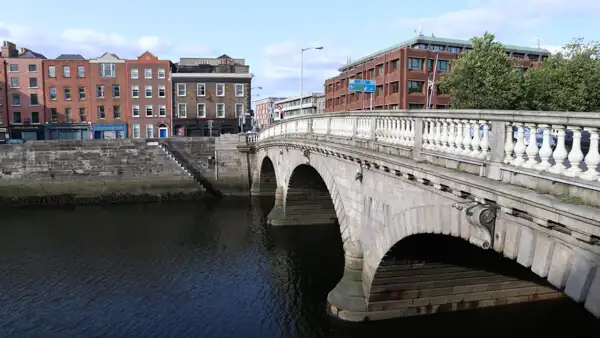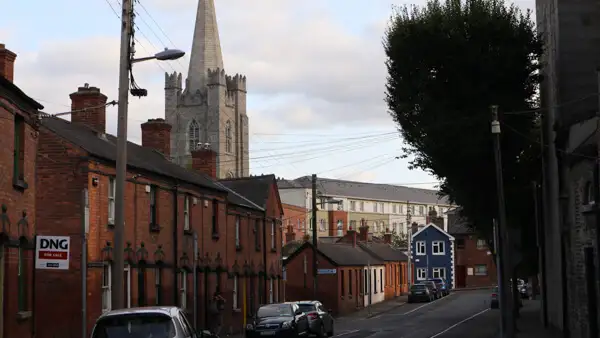The major sights of a city are beautiful and of course worth seeing. But the cityscape, away from the major attractions, also gives you a “feel” for the city. This also applies to Dublin…
Page Contents (click line to jump the text)

Intro
I stroll through the smaller streets of Dublin. I don’t know exactly where I am, and it doesn’t matter. The street is interesting, there are beautiful old houses, probably Georgian.
The wrought iron railings and door handles are ornate and many of the doors are skilfully carved from beautiful wood. Some are brightly painted. There is less traffic here than on the main street.
There are beautiful old trees. Cyclists pass through at a leisurely pace and a few boys play football on the pavement. The little shop on the corner looks good too. I let the impressions sink in and realise that I like this neighbourhood – where am I again…?
For me personally, a city doesn’t just live in its major sights, but also away from them. “Hidden gems” is what the Irish call these special places, which are often a little off the beaten track.
I know Dublin quite well, as we live just south of it. Originally from Germany, we have been living in Ireland for quite a few years now.
If you are also a fan of “hidden gems” and want to get a “feel” for Dublin away from the big sights, then I have a few nice tips for you below – to stroll around and discover:
Georgian quarters
Streets such as Fitzwilliam Square, Merrion Square, and Mountjoy Square are full of Georgian houses with their characteristic facades and symmetrical designs.
Grafton Street
Grafton Street is known for its shopping, but there are also some architecturally impressive historic buildings.
Molesworth Street and Kildare Street
This street offers a nice mix of historic and modern architecture. A few metres further on, in the equally beautiful Kildare Street, you will find the beautiful Seanad Éireann, the upper house of the Irish Parliament.
Trinity College Dublin
Admittedly, Trinity College is one of the most important sights in Dublin. But I’m not so much interested in the Long Room in the old library or the Book of Kells. Take your time to stroll around the campus and take in the architecture: The Campanile, the library and Parliament Square are particularly beautiful.
Temple Bar District
The Temple Bar neighbourhood and the Temple Bar Pub are certainly one of the main attractions. But you will also find some interesting architecture away from the tourist hustle and bustle, in the small side streets, alleyways and courtyards.

Merrion Square and Fitzwilliam Square
These small parks are close to each other. Here you will find some impressive Georgian buildings with colourful doors and neat facades. Not all the houses are beautiful, but some are.
Henrietta Street
This street is home to some of Dublin’s oldest Georgian buildings and showcases 18th century architecture. At the end you will find the historic King’s Inn, which is not a pub but the Faculty of Law. 14 Henrietta Street is a small museum about the lives of ordinary people in Georgian Dublin.
Clanbrassil Street
Clanbrassil Street is also interesting, with many small and tiny houses, quite different from the large facades of the big streets.

North Great George’s Street
Another street with an abundance of Georgian buildings and colourful doors typical of Dublin’s 18th century architecture.
Hanover Quay and Charlotte Qay
Here we are in the Docklands. Modern architecture and lots of water – I like it!
The Docklands to the left and right of Samuel Beckett Bridge
And Docklands again, modern architecture and harbour atmosphere.
Smithfield Square
In Smithfield Square you’ll find modern architecture, sometimes mixed with older buildings – an interesting mix of styles.

Dame Street
This street is home to some of the city’s most important historical buildings, including City Hall. Otherwise, it is a colourful mix of styles, but with many beautiful buildings.
Irishtown and Ringsend
You’ll find a completely different cityscape in the Irishtown and Ringsend neighbourhoods, close to the docks. Small and tiny, low houses, the old Dublin. The small street Aikenhead Terrace is a good example of this.
The Doors of Dublin
You will find many colourful facades, shop fronts and front doors in Ireland. Dublin is famous for its colourfully painted front doors, the Doors of Dublin. If you walk around St. Stephen’s Green, Fitzwilliam Square and Merrion Square, you will find many fine examples of Dublin’s colourful doors.
Conclusion
Monumental architecture or small houses, Georgian or modern, on the waterfront or by the city park, colourfully painted, or simply brick or large glass fronts by the water…Dublin has many faces.
In this article I have written down a few nice tips for you, but just go on a discovery tour yourself and let the streets of Dublin have an effect on you.
I wish you lots of fun in Dublin and many exciting discoveries!
More interesting articles for you
THE MOST IMPORTANT SIGHTS IN THE CITY OF DUBLIN
THE MUSEUMS OF DUBLIN
FREQUENTLY ASKED QUESTIONS AND ANSWERS ABOUT DUBLIN
Picture credits cover picture: Typical buildings at River Liffey, photo by Ulrich Knüppel-Gertberg (www.irland-insider.de, www.ireland-insider.com)